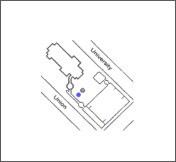



| Viewing Times |
|
||
|
Feb. 1 00:45 Feb. 15 23:45 Mar. 1 22:50 Mar. 15 21:55 Apr. 1 20:50 Apr. 15 20:55 |

|
||
|
The following text appears on the plaque: "Leo, one of the twelve zodiac constellations, lies on the ecliptic and represents the mythical lion defeated by Hercules. |
|||
Read more ...
The ecliptic marks the apparent annual path of the Sun across the sky. Regulus, Leo's brightest member, is a young, blue-white star that is situated 70 light-years from the Earth. Regulus is actually a multiple system whose two faint companions are not visible to the unaided eye. |
|||
| The blue mark indicates where to stand to see the alignment. |

|

See full website for detailed credits.
© Alison Tett, 2012. Website - Elliot Selick